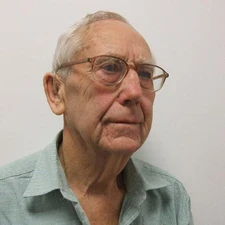Frank J. Lowes

The 2012 Petrus Peregrinus Medal is awarded to Frank J. Lowes for innovative research in geomagnetism, notably the first experimental geodynamo model, the spatial geomagnetic power spectrum, error analysis of satellite data, and leadership in the community developing the IGRF.
As long ago as 1952 Frank Lowes began his work that led to the world’s first successful laboratory dynamo in 1963. The importance of this contribution cannot be overstated – it reinforced Herzenberg’s ideas (which had grown out of Lowes’ own PhD thesis) and has become an important touchstone for today’s efforts to create a laboratory dynamo. In the 1960’s it was one of the wonders of the geophysical world that drew many to Newcastle. Cowling’s theorem had cast a great shadow over the dynamo theory, and the combination of rigorous theoretical demonstration of self-excitation and a tangible experiment was needed to establish it. The model dynamo was a significant technical achievement that even exhibited polarity reversals. It has been developed further by Wilkinson and Kerridge. Few people have a phenomena or quantity named after them within their lifetime, but Frank has one such quantity, the “Lowes power spectrum” (also known as the Lowes-Mauersberger or Mauersberger-Lowes spectrum), as a result of his 1966 paper that derived the spherical harmonic power spectrum for the geomagnetic field. On these grounds alone it is clear how influential his work has been. Lowes used this to demonstrate the combination of core and crustal field contained in surface measurements, with cross-over around spherical harmonic degree 14 (he found 12 in 1974, the increase is due to improved data). Lowes has more recently done much practical work on the error analysis for main field modeling, notably characterising the “perpendicular error” and its relationship with the Backus ambiguity, and separation of random and systematic errors in satellite data. This work continues today, and is being applied to the current generation of satellites. He has also contributed to our understanding of the fundamental difference between B and H, and persuaded IAGA to adopt its present approach to using B and M. In terms of service to the community, Lowes has for many years been known as the “conscience of geophysics” because of his tireless contributions to construction of the IGRF and immense reviewing efforts, writing reviews that were sometimes longer than the original paper. In summary, Lowes is a superb recipient of this award; it gives long-overdue recognition for 60 years of dedicated research and seminal contributions to our understanding of geomagnetism.
